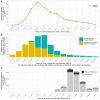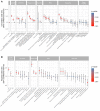Differential occupational risks to healthcare workers from SARS-CoV-2 observed during a prospective observational study
- PMID: 32820721
- PMCID: PMC7486122
- DOI: 10.7554/eLife.60675
Differential occupational risks to healthcare workers from SARS-CoV-2 observed during a prospective observational study
Abstract
We conducted voluntary Covid-19 testing programmes for symptomatic and asymptomatic staff at a UK teaching hospital using naso-/oro-pharyngeal PCR testing and immunoassays for IgG antibodies. 1128/10,034 (11.2%) staff had evidence of Covid-19 at some time. Using questionnaire data provided on potential risk-factors, staff with a confirmed household contact were at greatest risk (adjusted odds ratio [aOR] 4.82 [95%CI 3.45-6.72]). Higher rates of Covid-19 were seen in staff working in Covid-19-facing areas (22.6% vs. 8.6% elsewhere) (aOR 2.47 [1.99-3.08]). Controlling for Covid-19-facing status, risks were heterogenous across the hospital, with higher rates in acute medicine (1.52 [1.07-2.16]) and sporadic outbreaks in areas with few or no Covid-19 patients. Covid-19 intensive care unit staff were relatively protected (0.44 [0.28-0.69]), likely by a bundle of PPE-related measures. Positive results were more likely in Black (1.66 [1.25-2.21]) and Asian (1.51 [1.28-1.77]) staff, independent of role or working location, and in porters and cleaners (2.06 [1.34-3.15]).
Keywords: Covid-19; SARS-CoV-2; epidemiology; global health; healthcare workers; risk factors; serology; symptoms; virus.
© 2020, Eyre et al.
Conflict of interest statement
DE Lecture fees from Gilead, outside the submitted work, SL, DO, MC, ES, EL, FW, TJ, SC, AH, GD, SH, JK, KC, PF, JS, DV, FY, NS, PM, MD, TD, RS, LP, LD, AV, AA, BY, PD, AM, DS, FK, MN, MA, AB, NJ, LM, TC, BM, SH, RC, DC, DS, GS, TP, BH, AO, DE, CC, KJ, TW No competing interests declared
Figures








References
-
- Adams ER, Ainsworth M, Anand R, Andersson MI, Auckland K, Baillie JK, Barnes E, Beer S, Bell JI, Berry T, Bibi S, Carroll M, Chinnakannan SK, Clutterbuck E, Cornall RJ, Crook DW, de Silva T, Dejnirattisai W, Dingle KE, Dold C, Espinosa A, Eyre DW, Farmer H, Fernandez Mendoza M, Georgiou D, Hoosdally SJ, Hunter A, Jefferey K, Kelly D, Klenerman P, Knight J, Knowles C, Kwok AJ, Leuschner U, Levin R, Liu C, López-Camacho C, Martinez J, Matthews PC, McGivern H, Mentzer AJ, Milton J, Mongkolsapaya J, Moore SC, Oliveira MS, Pereira F, Perez E, Peto T, Ploeg RJ, Pollard A, Prince T, Roberts DJ, Rudkin JK, Sanchez V, Screaton GR, Semple MG, Slon-Campos J, Skelly DT, Smith EN, Sobrinodiaz A, Staves J, Stuart DI, Supasa P, Surik T, Thraves H, Tsang P, Turtle L, Walker AS, Wang B, Washington C, Watkins N, Whitehouse J, National COVID Testing Scientific Advisory Panel Antibody testing for COVID-19: a report from the National COVID Scientific Advisory Panel. Wellcome Open Research. 2020;5:139. doi: 10.12688/wellcomeopenres.15927.1. - DOI - PMC - PubMed
-
- Aerosol Generating Procedures Health protection Scotland and NHS Scotland. [June 17, 2020];2020 https://hpspubsrepo.blob.core.windows.net/hps-website/nss/2893/documents...
-
- Disparities in the risk and outcomes from COVID-19 Public health England. [June 12, 2020];2020 https://assets.publishing.service.gov.uk/government/uploads/system/uploa...
-
- Folgueira MD, Munoz-Ruiperez C, Alonso-Lopez MA, Delgado R. SARS-CoV-2 infection in health care workers in a large public hospital in Madrid, Spain. medRxiv. 2020 doi: 10.1101/2020.04.07.20055723. - DOI
-
- Galan I, Velasco M, Casas ML, Goyanes MJ, Rodriguez-Caravaca G, Losa JE. SARS-CoV-2 seroprevalence among all workers in a teaching hospital in Spain: unmasking the risk. medRxiv. 2020 doi: 10.1101/2020.05.29.20116731. - DOI
Publication types
MeSH terms
Grants and funding
- Intermediate Fellowship 110110/Z/15/Z/WT_/Wellcome Trust/United Kingdom
- Senior Investigator/WT_/Wellcome Trust/United Kingdom
- Clinical Research Fellow/WT_/Wellcome Trust/United Kingdom
- MC_UU_00008/6/MRC_/Medical Research Council/United Kingdom
- MR/V001329/1/MRC_/Medical Research Council/United Kingdom
- MR/N00065X/1/MRC_/Medical Research Council/United Kingdom
- MRF-145-004-TPG-AVISO/MRF/MRF/United Kingdom
- Clinical Research Training Fellow 216417/Z/19/Z/WT_/Wellcome Trust/United Kingdom
- WT_/Wellcome Trust/United Kingdom
- MRF-145-0004-TPG-AVISO/MRF_/MRF_/United Kingdom
- NIHR300249/DH_/Department of Health/United Kingdom
LinkOut - more resources
Full Text Sources
Miscellaneous

